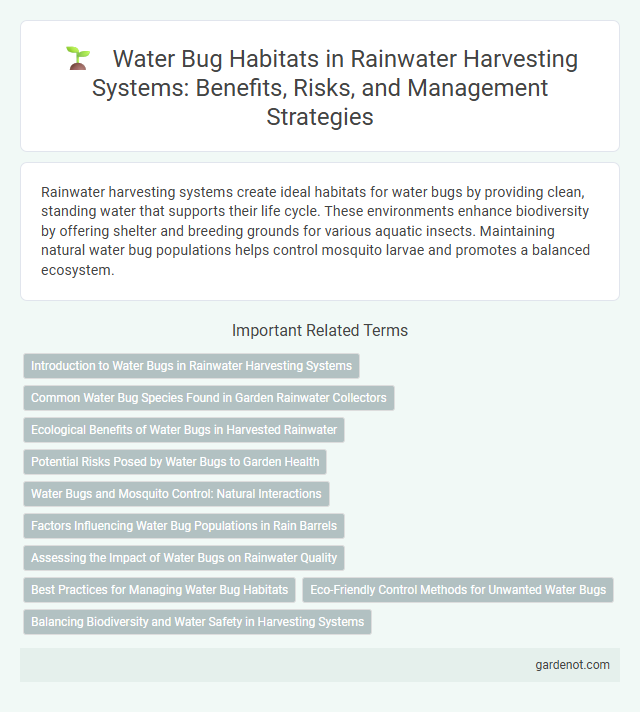Rainwater harvesting systems create ideal habitats for water bugs by providing clean, standing water that supports their life cycle. These environments enhance biodiversity by offering shelter and breeding grounds for various aquatic insects. Maintaining natural water bug populations helps control mosquito larvae and promotes a balanced ecosystem.
Introduction to Water Bugs in Rainwater Harvesting Systems
Water bugs serve as crucial bioindicators within rainwater harvesting systems, reflecting the ecological health of stored water. These aquatic insects thrive in still water environments, where they contribute to natural pest control by preying on mosquito larvae, thus aiding in maintaining water quality. Understanding the role of water bugs enhances the efficiency and sustainability of rainwater harvesting by promoting balanced aquatic ecosystems.
Common Water Bug Species Found in Garden Rainwater Collectors
Common water bug species found in garden rainwater collectors include Notonecta glauca (backswimmers), Nepa cinerea (water scorpions), and Corixa punctata (water boatmen). These insects thrive in stagnant water environments typical of rainwater harvesting tanks and provide natural pest control by feeding on mosquito larvae and other small aquatic organisms. Maintaining clean rainwater collectors helps support these beneficial species, enhancing garden biodiversity and reducing mosquito-borne disease risks.
Ecological Benefits of Water Bugs in Harvested Rainwater
Water bugs in harvested rainwater create a vital habitat that supports biodiversity by serving as both predators and prey in aquatic ecosystems. Their presence helps control mosquito larvae populations, reducing the spread of vector-borne diseases. These insects contribute to nutrient cycling and organic matter breakdown, enhancing the ecological balance within rainwater harvesting systems.
Potential Risks Posed by Water Bugs to Garden Health
Water bugs in rainwater harvesting systems can pose significant risks to garden health by serving as vectors for plant pathogens and disrupting the local ecosystem balance. Their presence may lead to increased instances of plant diseases due to the transmission of harmful bacteria and fungi. Monitoring and managing water bug populations is essential to maintain optimal plant growth and prevent damage in garden environments.
Water Bugs and Mosquito Control: Natural Interactions
Water bugs play a crucial role in natural mosquito control by preying on mosquito larvae in rainwater harvesting systems, reducing the need for chemical interventions. Their presence in water storage habitats creates a balanced ecosystem that limits mosquito breeding, promoting healthier, pest-free environments. Encouraging water bug habitats within rainwater containers supports sustainable mosquito management and enhances water quality.
Factors Influencing Water Bug Populations in Rain Barrels
Water bug populations in rain barrels are influenced by factors such as water quality, barrel design, and organic matter availability. Stagnant water with ample organic debris creates an ideal habitat, promoting egg laying and larval development. Temperature and sunlight exposure also impact growth rates and survival of water bugs in harvested rainwater systems.
Assessing the Impact of Water Bugs on Rainwater Quality
Water bugs play a significant role in rainwater harvesting systems by influencing water quality through their natural activities and habitat presence. Their interaction with decomposing organic matter can alter microbial communities, potentially affecting the nutrient levels and clarity of stored rainwater. Assessing the impact of water bugs involves monitoring biological indicators and water parameters to ensure optimal rainwater quality for safe usage.
Best Practices for Managing Water Bug Habitats
Maintaining water bug habitats in rainwater harvesting systems requires regular monitoring to ensure water quality and prevent stagnation, which can breed harmful pathogens. Incorporating natural vegetation around storage tanks promotes biodiversity and provides shelter for beneficial aquatic insects, enhancing ecosystem health. Employing mesh covers on rainwater collection surfaces prevents debris and predators from contaminating water bug habitats, supporting sustainable habitat management.
Eco-Friendly Control Methods for Unwanted Water Bugs
Eco-friendly control methods for unwanted water bugs in rainwater harvesting systems include maintaining clean, well-sealed storage containers to prevent bug entry and reduce breeding sites. Introducing natural predators like fish or aquatic insects helps regulate water bug populations without harmful chemicals. Regularly monitoring water quality and removing debris also minimizes habitats favorable to water bugs, supporting sustainable water conservation efforts.
Balancing Biodiversity and Water Safety in Harvesting Systems
Rainwater harvesting systems can serve as vital habitats for water bugs, supporting local biodiversity by providing breeding and feeding grounds. Designing these systems with properly managed filtration and maintenance ensures the water remains safe for human use while sustaining aquatic life. Incorporating natural vegetation and avoiding chemical contaminants balances ecosystem health with water quality in harvested rainwater.
Water bug habitat Infographic

 gardenot.com
gardenot.com